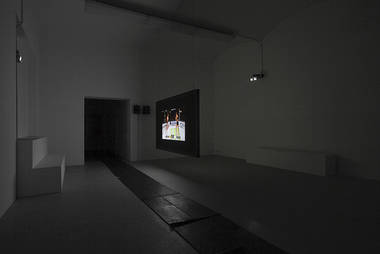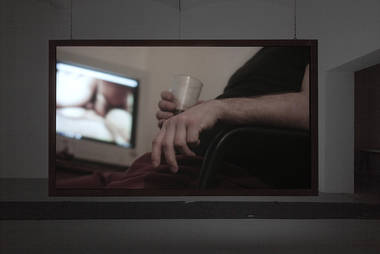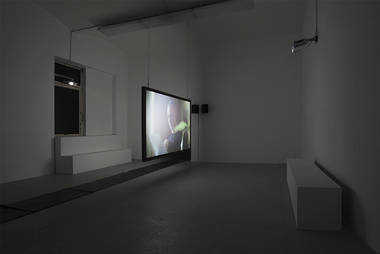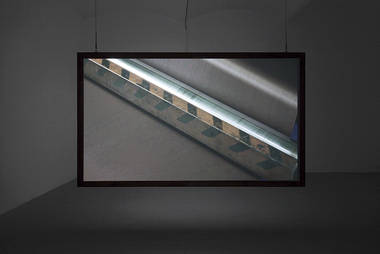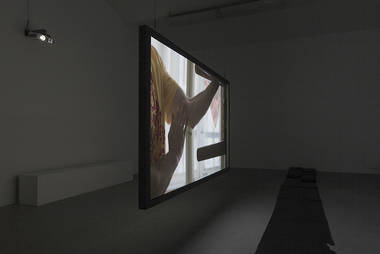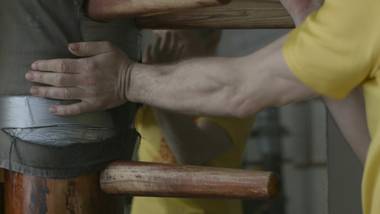Alžběta Bačíková: Heroes
22. 3. – 16. 4. 2017
opening: 21. 3. 2017 at 6 pm
curated by: Anna Remešová
architect of the exhibition: Jakub Červenka
“If, however, we perceive the truth historically, what else can we say about the fact whether history is also truthful?”
Hito Steyerl
Alžběta Bačíková chose a classical documentary portrait as the subject of examination in her last video. That corresponds to her selection of one single protagonist, directing the viewer’s attention to his figure, the way of narrating and the places of his daily activities. The portrait “hero” is Eda, whom the camera, in Alžběta’s hands, follows at home at his computer, during his kung-fu training in the gym or recording in the tyre factory environment where Eda works. We can identify the form of a documentary portrait quite early on in watching this as we see certain elements – such as the gradual entrance with a view of the street and instrumental music, which are deeply imbedded in us thanks to television documentaries. And they are precisely these elements, on which Alžběta builds her question that continues to arise during the entire film: In what way does the protagonist’s subjectivity get constituted through the form of a documentary view?
Eda, who is passionately immersed in traditional Chinese culture and kung-fu, as well as engaged in writing short stories, received a task from Alžběta to write a story about the historical figure of Qiu Jin, whom Wikipedia characterizes as a revolutionary, feminist and writer. The type of story that Eda wrote falls in the traditional genre of Chinese stories called wuxia, which focuse on the depiction of the legends of fighters and war heroes. In the end Eda’s portrait alone is not built on his own story but on the assignment prepared by the author of the film. Eda is placed in a situation where he is partially loosing the solid ground under his feet, but the conscious view of the camera does not allow him to hesitate. There is too much in the game.
We get to know the protagonist primarily through visual picture. The film completely leaves out the passage where Eda would have the opportunity to introduce himself. On the contrary, he is manipulated into the role of a narrator of stories, which are working with real historical figures; however, the legends built around them are completely fictive. In this way the film works with fiction and storytelling on several levels – they are films that Eda watches, stories that he tells, and the camera view that follows him.
The division of the film into a two-channel presentation demonstrates the effort to disrupt one of the dominant views. Both of the simultaneously running pictures are sometimes complementing one another, other times disrupting one another, and the viewer is forced to guess these relations when crossing from one side to the other. We eventually come back to the question from the introductory citation by Hito Steyerl. Are we interested in history or in the present as well, we are listening to information and facts, we watch the news on TV, we surf the Internet, but how much can we speak about learning and how much about constituting the truth? Eda does not present the historical hero in his storytelling, he creates her. He narrates. His narrative much more perceptible when we realize the time, cultural and gender gaps, which linger between both protagonists. Although Alžběta lets him speak, her editing and camera work is far from a mere recording. In the artist’s interpretation the documentary portrait itself becomes primarily the contemplation over the reflected documentary instruments as well as her work with different forms of reality and fiction.
Anna Remešová
Jeleni Gallery exhibition program is possible through kind support of Ministry of Culture of the Czech Republic, Prague City Council, State Fund of Culture of the Czech Republic, City District Prague 7
Media support: Artycok.tv, ArtMap, jlbjlt.net and UMA: You Make Art
